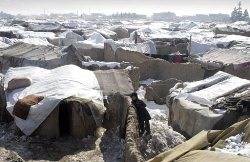Every day 400 Afghans become internally displaced, according to Amnesty International. At that rate, more than 2,500 Afghans were left homeless in the week of violent protests that swept the country recently over the burning of copies of the Noble Quran at the US-led Bagram airbase.
They joined the ranks of internally displaced people (IDPs), already crowding makeshift camps that dot Afghanistan’s urban centers.
"It was incredible to see how people young and old could survive such poverty, destruction and filth" said Fatima Popal, an aid worker with the Kabul-based Aschiana Foundation, after visiting some of the camps during Afghanistan's harsh winter that has already claimed 40 lives this year.
Among the hapless crowds, Popal saw children without shoes, socks or jackets walking to tattered and worn tents that provided little or no protection against the biting cold.
But yet, the squalid camps are seen as the last refuge by Afghans fleeing violence back home.
By Amnesty's estimates, the number of IDPs touched 500,000 last month - a figure that is certain to swell further.
Once in the camps, aid agencies say the inhabitants are made to fend for themselves, with the government virtually forsaking those who were forced to flee their homes.
"They [the government] are continuing to ignore a growing problem," says Horia Mosadeq, a researcher with Amnesty International.
'Callous indifference'
In a new report titled "Fleeing war, finding misery," the London-based rights group said the government's initiatives for the IDP's were "inconsistent, insufficient and ineffective" and said it "essentially has no plan to address internal displacement". The report also accused the government of "callous indifference" towards the IDPs.
In its defense, the government says its efforts to tackle the crisis come down to a matter of resources like all things in Afghanistan.
“The government has done as much as we can given the resource constraints” said M Ashraf Haidari, the deputy assistant national security adviser, who once was displaced himself.
That the government's best efforts are woefully inadequate are borne out by the harsh realities at the camps.
As the Amnesty report details, families in IDP camps are given no more than 10 liters of water per person per day to cook, wash, and drink, and many have access to health care workers no more than once or twice per week.
Crucial funds remain unutilized even as people in the camps await succor. "Many ministries lack the professionalism, expertise and political will to spend funds properly," says Amnesty's Mosadeq, referring to reports that the ministry of refugees spent only 38 per cent of its $3m budget last year.
Accessing whatever little benefits that are available is also not easy for the IDPs.
The government insists that the national identity card called the taskrieh must be obtained from one's home province. The ID cards are required for everything from starting a business to buying land and enrolling in school, Mosadeq says.
But sheltering in urban centers, the IDPs find it difficult to procure a card. The journey home to pick up an identity card can be both physically and financially hazardous.
Many blame the government's insensitivity for the IDP's misery.
The Amnesty report was critical of the government's attempt to label the IDPs as just another segment of the nation’s poor. According to it, many officials tend to describe those displaced as "economic migrants' who are no worse than other Afghans living in poverty.
"It means we all get bogged down in whether the displacement is poverty-induced or conflict-induced...it [the debate] is very unhelpful," lamented an unnamed aid worker in the Amnesty report.
It certainly did not help when authorities in the southwestern province of Herat sent out letters to the UN and other aid agencies, instructing them not to direct their assistance to IDPs in particular.
The authorities often intervene directly to deprive the IDPs of assistance, besides being plain unhelpful.
As Mosadeq points out, the government stopped NGOs, particularly in Kabul, from building water pumps and providing heating in the camps.
The government has also banned the sinking of wells at the camp sites, lest the IDPs gain permanency at their new address.
Further, the Amnesty report cited an international NGO complaining that the department of labor and social affairs, along with the department of refugees and repatriation, did not want IDP children included in a program targeting street children.
Haidari admitted the government was afraid the camps will become "magnets" for the other impoverished residents of the cities.
'Unwelcome guests'
Adding to the challenges facing IDPs in Afghanistan’s larger cities – Kabul, Herat, Mazar-e-Sharif, Kandahar, and Jalalabad – are tensions with the local city-dwellers.
Mosadeq says often when IDPs arrive in the cities they are unfamiliar with the cultures of the urban centers and are quickly ostracized by impoverished locals.
Haidari says poor locals, who themselves are in need of support; see the IDPs as “getting special treatment”.
IDPs are often accused of not properly managing the land and exacerbating the city's poor sanitation situation.
Raising a stink are also disputes that often break out between IDPs and other residents over land ownership.
Many - locals and war lords - have their eyes set on grabbing lands the IDPs occupy and those who had fled homes to seek refuge in urban centers find themselves engulfed in fresh hostility.
PHOTO CAPTION
An internally displaced Afghan youth from Helmand province stands outside a makeshift tent at a refugee camp in Kabul, Afghanistan, Tuesday, Feb. 7, 2012.
Source: Aljazeera.com


 Home
Home Discover Islam
Discover Islam Quran Recitations
Quran Recitations Lectures
Lectures
 Fatwa
Fatwa Articles
Articles Fiqh
Fiqh E-Books
E-Books Boys & Girls
Boys & Girls  Articles
Articles










